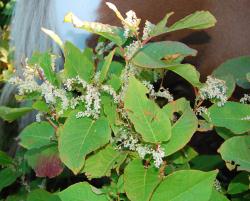- Taxon
- Weed
- Gallery
Rhizomatous herb forming large clumps; stems usually 1–2–(2.5) m tall, c. 1.5 cm diam. at the woody base, ± zigzagging, glabrous, ± glaucous to reddish. Petiole 1–5.5 cm long, ± dark crimson, channelled above, with a single pit at base on dorsal side. Lamina 8–23 × 5–17 cm (infl. lvs often smaller and more elongated), broad-ovate, somewhat glaucescent below, with < 14 pairs of lateral veins, often minutely puberulent on veins near base above, otherwise glabrous, ± undulate; base usually truncate, sometimes shallowly subcordate especially on vegetative shoots; apex cuspidate. Ochreae to c. 3 cm long, deciduous, glabrous. Panicles with branches clustered, to 6 cm long, > petioles, erect or suberect, densely puberulent. Bracts small, glabrous or puberulent, cuspidate or cuspidate-acuminate. Pedicels > bracts, glabrous, jointed in lower 1/2. Perianth 1.5–2.5 mm long at anthesis (excluding decurrent base), white; segments obovate to oblong-obovate, keeled. Filaments to 2 mm long. Stigmas fimbriate. Valves of fr. 7–11 mm long (including broad wing); apex notched. Nut 2.5–3 mm long, obtusely angled, glossy brown.
[From: Webb et al. (1985) Flora of New Zealand. Volume 4 as Reynoutria japonica Houtt.]




